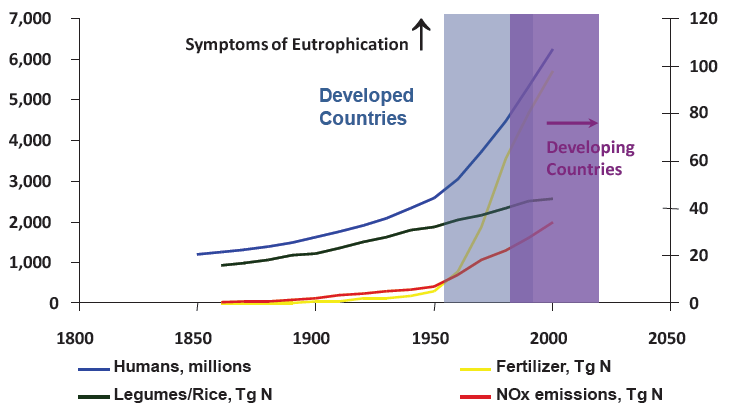Estimated disruptions to Earth’s great elemental cycles

23 March 2016 (Desdemona Despair) – Back in 2011, Desdemona was asked by a local church to give a presentation on the condition of the world’s oceans (State of the Oceans 2011 video; pdf slide deck; PowerPoint). As part of the talk, Des wanted estimates for human disturbances to the great cycles of elements on which the entire biosphere depends: nitrogen, sulfur, phosphorus, and carbon. Humans are mining these elements from buried reservoirs and releasing them into the environment at rates that are unprecedented in Earth’s 4+ billion-year history. So how much are humans really liberating?
This turned out to be a surprisingly difficult question to answer. After much searching, Des finally found estimates for global nitrogen and sulfur emissions buried in problem sets from a textbook on biogeochemical cycles. The estimate for phosphorus came from a 2011 paper published in Environmental Research Letters. Of course, the estimate for carbon is well known, due to increased interest in curtailing CO2 pollution.

Desdemona converted the cited values to megatons/year to compare the magnitude of the excursions in the four biogeochemical cycles. Obviously, human carbon emissions comprise the largest disturbance by far, on the order of 9 billions tons of carbon emitted each year, mostly from burning fossil fuels. But agriculture drives the emission of millions of tons of nitrogen and phosphorus each year: in ten years, humans release around 800 megatons of nitrogen and up to 320 megatons of phosphorus into the environment.
Probably the most visible effect of phosphorus pollution is the creation of enormous dead zones in lakes and oceans, caused by nutrient loading and eutrophication. Nitrogen pollution is more insidious but no less devastating, contributing to lethal air pollution and large-scale destruction of forests. Despite increased efficiencies in agriculture (or, perhaps, because of them: see Jevons paradox), emissions of phosphorus and nitrogen continue to increase.

Since the appearance of the ancient prokaryotes, some 4 billion years ago, Earth’s biosphere has never experienced gigantic disruptions to all four of the fundamental elemental cycles simultaneously. We know what happens when Earth experiences large perturbations to the carbon cycle alone: mass extinctions. There is no reason to expect that the biosphere will fare better when the other cycles are disrupted at the same time.



Did you not find what you were looking for in Planetary Boundaries? Or maybe they don't quantify it? The EU is constantly issuing reports about nitrogen, here's an old one: http://www.unep.org/pdf/dtie/Reactive_Nitrogen.pdf